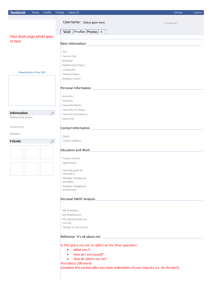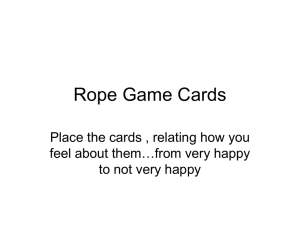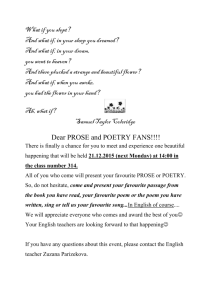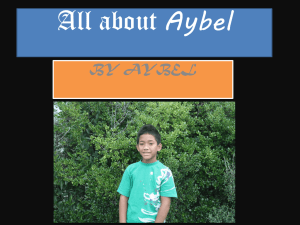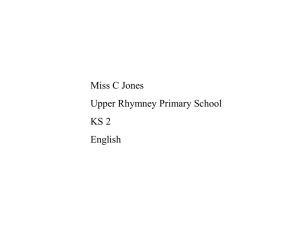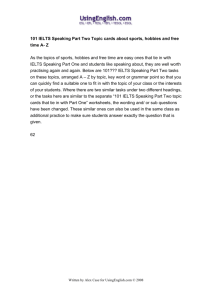Y6 Literacy leaflet for Parents
advertisement
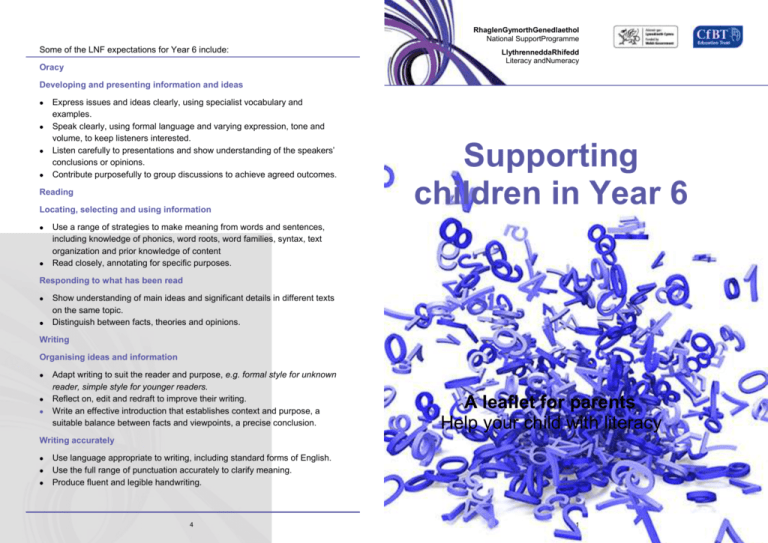
RhaglenGymorthGenedlaethol National SupportProgramme Some of the LNF expectations for Year 6 include: Oracy LlythrenneddaRhifedd Literacy andNumeracy Developing and presenting information and ideas Express issues and ideas clearly, using specialist vocabulary and examples. Speak clearly, using formal language and varying expression, tone and volume, to keep listeners interested. Listen carefully to presentations and show understanding of the speakers’ conclusions or opinions. Contribute purposefully to group discussions to achieve agreed outcomes. Reading Locating, selecting and using information Supporting children in Year 6 Use a range of strategies to make meaning from words and sentences, including knowledge of phonics, word roots, word families, syntax, text organization and prior knowledge of content Read closely, annotating for specific purposes. Responding to what has been read Show understanding of main ideas and significant details in different texts on the same topic. Distinguish between facts, theories and opinions. Writing Organising ideas and information Adapt writing to suit the reader and purpose, e.g. formal style for unknown reader, simple style for younger readers. Reflect on, edit and redraft to improve their writing. Write an effective introduction that establishes context and purpose, a suitable balance between facts and viewpoints, a precise conclusion. A leaflet for parents Help your child with literacy Writing accurately Use language appropriate to writing, including standard forms of English. Use the full range of punctuation accurately to clarify meaning. Produce fluent and legible handwriting. 4 1 Supporting your Year 6 child. Oracy Reading Ask your child to find specific information for you on a computer or tablet. Once they find this information, ask them to give you a verbal summary of the information that they found. Encourage your child to set up a reading club at home, inviting friend or family members to become members. Club members could select their ‘book of the week’, organise book discussion forums and ‘live’ reading from favourite books etc. Encourage your child to participate in family discussions, e.g. during meal times, and guide them to listen carefully to what other people are saying and to respond appropriately by asking questions or explain why they agree or disagree with someone’s viewpoint. Don’t forget that games like karaoke require on-screen reading (and performance) which children usually love to play with friends and family. Setting up games, such as on the Wii, involve reading and understanding instructions, so make sure that your child can do this for themselves (although they normally teach us). Set up opportunities for your child to role-play their favourite sports personality, singer, tv celebrity etc. Encourage your child to find information about the person of their choice and then use ‘hot seating’ to test their knowledge about the person – they sit in the ‘hot seat’ and try to answer the questions that you pose. Show your child a recipe and go over it together. Ask your child to read the recipe to you as you work, and tell the child that each step must be done in a special order. Let your child help mix the ingredients. Your child could write down other recipes from a cookbook or from the internet, that he or she would like to help make. You could watch a television programme or film with your child and then ask them questions about the contents, getting them to express their opinions and preferences. Talk to your child about the articles in your local or national free /electronic/ daily newspaper or news watched on the television. Discuss the possibility of your child taking up a new hobby. Once you have agreed on a suitable hobby that really interests your child, encourage them to find as much information as possible online and in books about their new hobby. They could make digital notes of the information that they find. Involve your child in discussions about the planning and organising of day trips, holidays, visiting other family members etc. 2 Encourage your child to read suitable stories and factual material to younger siblings. 3 RhaglenGymorthGenedlaethol National SupportProgramme LlythrenneddaRhifedd Literacy andNumeracy Writing Ask your child to gather old photos or pictures from magazines and Encourage your child to make up his/her own crossword puzzles or word searches for friends and family. This will help to develop vocabulary and dictionary skills. Scrabble is a classic spelling game – guaranteed to get the family talking and possibly lead to some disagreement! Play around with anagrams to help with patterns and spelling, e.g. make as many words as you can out of longer words or names of places. Inspire your child to write about their family story. You could collect photos of relatives from as many generations as possible and help your child create an informal family tree or timeline, weaving in as many memorable tales as you can throughout the process. You and your child can also start a family storybook. Encourage your child to write some of her favourite anecdotes and put them alongside related photos or mementos in a bound book. Additional pages could be added as she continues to learn more about your family’s history. Encourage your child to carry a notebook and write down ideas and interesting things that your child sees or hears throughout the day. Being an active observer of the world is critically important to becoming a gifted writer. Help your child start a journal. Firstly, you could discuss the different topics that can be written about, such as making a new friend, or an interesting school or home activity just completed. You could also keep a journal yourself and compare notes at the end of the week. You and your child could read aloud parts of your journals that you want to share. 4 encourage them to make up a story based on the images, or have them make up stories for photographs they have taken of things that catch their eye. You could challenge them to create a story for a wordless picture book, prompting your child’s interpretation of the images they see with questions, e.g. What’s going on here? Why does this character look worried? You can also start a story yourself and then encourage your child to complete the story. After your child describes what should happen next, you could take turns adding events to the story. You could set aside a special time and place to write every day. Many families enjoy a daily reading time, and in a similar way you could setaside some writing time—even if it’s just for ten minutes. If your child isn’t writing yet, you can take this opportunity to transcribe their ideas. In addition, encourage your child to find a special “writing place” where they feel inspired to write or think: it can be in bed, at the kitchen table, a favourite chair, or even outside. 1 2 3

